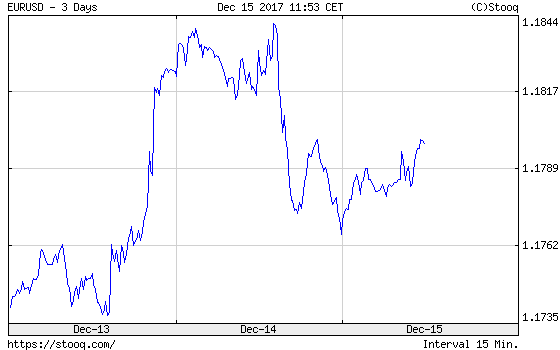On Thursday, the European Central Bank released its most recent monetary policy statement. What does it say about the ECB’s stance and what does it imply for the gold market?
It was a hot weekend for central banking. On Wednesday, the FOMC hiked interest rates and presented fresh economic projections. We will come back to this event on Monday, but today we will analyze yesterday’s ECB meeting.
Contrary to the Fed, the ECB kept its monetary policy unchanged. But similarly to the U.S. central bank, it substantially upgraded its outlook for real GDP growth. For example, the central bank sees a 2.3 percent jump next year, up sharply from the previous estimate of 1.8 percent. Indeed, Draghi’s introductory remarks sounded rather hawkish:
The incoming information, including our new staff projections, indicates a strong pace of economic expansion and a significant improvement in the growth outlook. The strong cyclical momentum and the significant reduction of economic slack give grounds for greater confidence that inflation will converge towards our inflation aim.
The solid momentum in Eurozone growth should be bullish for the euro and, thus, for gold, as these currencies are positively correlated. However, the ECB remained more conservative on inflation projections. Inflation is expected to rise 1.4 percent in 2018, up from the previous estimate of 1.2 percent. But it is projected to reach only 1.7 percent in 2020, which would not be close enough to the ECB’s target. As Draghi explained:
Domestic price pressures remain muted overall and have yet to show convincing signs of a sustained upward trend. An ample degree of monetary stimulus therefore remains necessary for underlying inflation pressures to continue to build up and support headline inflation developments over the medium term.
What does it mean for the ECB’s stance and the gold market? Well, on one hand, with an accelerating economy and rising inflation, “deflation risks have disappeared”, so the ECB could adopt a more hawkish stance. But on the other hand, the ECB hinted that there was no hurry to end its monthly bond-purchase program, even as it was more optimistic about economic growth in the Eurozone. During the press conference, Draghi pointed out that the ECB’s mandate was not growth, not employment, but price stability. Hence, with subdued inflation, “it’s quite early before we talk about changing our monetary policy support.”
It means that the divergence between interest rates in the U.S. and in the Eurozone would increase, which should support the greenback against the euro. Indeed, the EUR/USD declined yesterday after the ECB meeting, as one can see in the chart below.
Chart 1: EUR/USD exchange rate over the last three days.

However, the chart also shows that the euro came out stronger overall after both the Fed and ECB meetings. It suggests that investors believe that the Fed will be actually more dovish than it says, while the ECB will be more hawkish than it claims. Funny, huh? It may be also the case that investors are buying rumor, so the euro will be strengthening in the anticipation of the tightening cycle. Funny or not, it should be positive for gold, which shines when the U.S. dollar depreciates against its major peers. Stay tuned!
If you enjoyed the above analysis, we invite you to check out our other services. We focus on fundamental analysis in our monthly Market Overview reports and we provide daily Gold & Silver Trading Alerts with clear buy and sell signals. If you’re not ready to subscribe yet and are not on our gold mailing list yet, we urge you to sign up. It’s free and if you don’t like it, you can easily unsubscribe. Sign up today.
Disclaimer: Please note that the aim of the above analysis is to discuss the likely long-term impact of the featured phenomenon on the price of gold and this analysis does not indicate (nor does it aim to do so) whether gold is likely to move higher or lower in the short- or medium term. In order to determine the latter, many additional factors need to be considered (i.e. sentiment, chart patterns, cycles, indicators, ratios, self-similar patterns and more) and we are taking them into account (and discussing the short- and medium-term outlook) in our trading alerts.
Thank you.
Arkadiusz Sieron, Ph.D.
Sunshine Profits‘ Gold News Monitor and Market Overview Editor
Gold News Monitor
Gold Trading Alerts
Gold Market Overview


